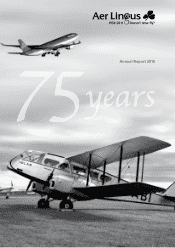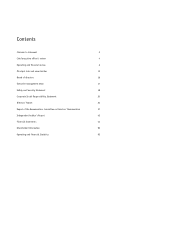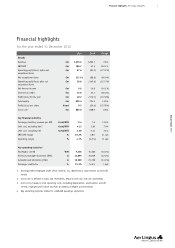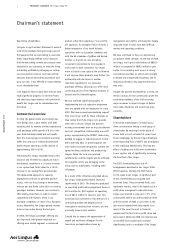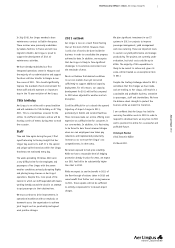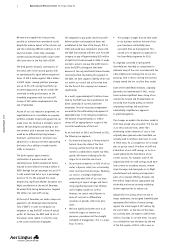Aer Lingus 2010 Annual Report Download - page 4
Download and view the complete annual report
Please find page 4 of the 2010 Aer Lingus annual report below. You can navigate through the pages in the report by either clicking on the pages listed below, or by using the keyword search tool below to find specific information within the annual report.
2
Annual Report 2010
Chairman’s statement Aer Lingus Group Plc
Chairman’s statement
Dear fellow shareholders,
Last year in my Chairman’s Statement I wrote of
some of the problems facing Aer Lingus and of
the measures that we were taking to overcome
them. I specifi cally referred to the measures
that we were taking to make our products more
attractive to our customers, to make the Group
sustainably profi table by changing our culture,
our work practices and our cost base and the
measures that we were taking to preserve and
grow our cash. I also referred to issues relating
to our shareholder base.
I am happy to report a year later that we have
made signifi cant progress on all these fronts
and that these improvements will continue to
benefi t Aer Lingus and its shareholders into
the future.
Commercial overview
In 2010 the global airline environment was
more benign than a year earlier, with IATA
reporting that its member airlines experienced
total passenger traffi c growth of 8.2% in the
year. Unfortunately Ireland did not benefi t
from this more benign environment and total
traffi c into and out of Ireland declined with
Dublin Airport reporting a traffi c decline of
approximately 10% in 2010.
Fortunately Aer Lingus responded well to this
situation and trimmed its capacity to match
the demand, resulting in a 1.6 point increase
in our system load factor allied to a 12.0%
increase in our average fare per passenger.
This demand-led approach to capacity
deployment continues to generate positive
results, with our focus being on maximising
revenue per seat fl own rather than on chasing
passenger numbers. However, we continue to
offer keenly priced fares in order to remain
competitive with Ryanair, which is our
strongest competitor on most of our European
routes. Meanwhile, Aer Lingus gained market
share on key routes during the last year.
In 2010, Aer Lingus’ passenger offering was
also improved, with greater emphasis on
offering each market segment a customised
product rather than adopting a “one size fi ts
all” approach. An example of this has been a
better integration of our North Atlantic
operations with our European schedules and
with the US schedules of jetBlue and United
Airlines so that we are now providing
convenient connections to more people in
more cities in both continents. Our recent
move to Dublin’s new state of the art Terminal
2 will improve these products even further. Our
partnership with Aer Arann is another
important ingredient in our improved
passenger offering, allowing us to offer more
connecting services from regional locations in
Ireland and the United Kingdom.
We also achieved signifi cant progress in
implementing the cost reduction programme
that was agreed with our employees in early
2010. We have received overwhelming support
from most of our staff for these initiatives as
they realise that if Aer Lingus is to provide
them with a secure, vibrant and positive
working environment then we must be effi cient
and cost competitive. Unfortunately one staff
group, represented by the IMPACT trade union,
decided to engage in industrial action in late
2010 and early 2011 in protest against the
new rosters that were designed to achieve the
agreed working conditions and productivity
targets. While the issue was resolved
satisfactorily, and the targets will be achieved,
this negative action was damaging to the
Group and its stakeholders, including their
colleagues.
As a result of the initiatives described above,
Aer Lingus’ trading performance improved
signifi cantly in 2010. The Group has produced
an operating profi t before exceptional items of
€57.6 million for 2010 against an operating
loss of €81.0 million in the prior year. This
turnaround was achieved on fl at revenues in a
contracting market and despite service
interruptions resulting from volcanic ash and
unusually severe winter weather.
I would like to express the appreciation of
myself and my Board colleagues for the
innovation and application shown by
management and staff in achieving this hugely
improved result in what have been diffi cult
market and operating conditions.
We have continued to focus on maintaining
our balance sheet strength. At the end of 2010
Aer Lingus had a gross cash balance of €885.0
million as compared to €828.5 million a year
earlier. In an industry such as ours a strong
cash balance provides an airline with strength
to endure any unexpected disruptions and to
respond positively to any opportunities that
may arise.
Despite the positive developments in 2010, we
remain cautious for the current year, given the
continuing weakness of the Irish economy,
major increases in airport charges at Dublin
and London Heathrow and recent fuel price
volatility.
Shareholders
In 2010 we made progress in reducing our
share concentration among a small group of
shareholders by ensuring that the block of
shares held in trust on behalf of current and
former employees by the Aer Lingus Employee
Share Ownership Trust (“ESOT”) was distributed
to the individual benefi ciaries. This had the
effect of adding over 4,000 new shareholders
to our register and of signifi cantly increasing
the free fl oat of Aer Lingus.
The ESOT shareholding arose out of
arrangements described in Aer Lingus’ 2006
IPO Prospectus, whereby the ESOT held a
12.5% stake in Aer Lingus. A signifi cant part
of this shareholding was acquired with
borrowed funds. These borrowed funds, and
applicable interest, were to be repaid out of a
profi t share arrangement under which Aer
Lingus was required to pay up to 7.5% of its
annual profi t before tax and exceptional items
until the earlier of 2023 or such time as the
loan and all interest were fully repaid. As a
result of the recent turmoil in fi nancial
markets and the fact that no profi t share had
been paid in 2008 and 2009, the interest rate
on the ESOT loan would have increased
signifi cantly (and to a multiple of Aer Lingus’

